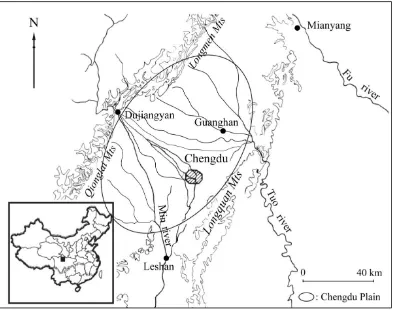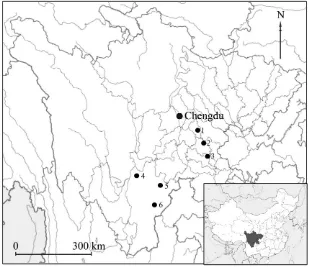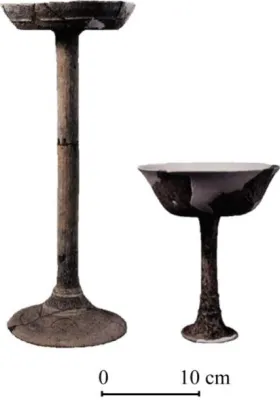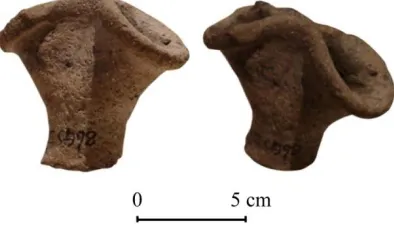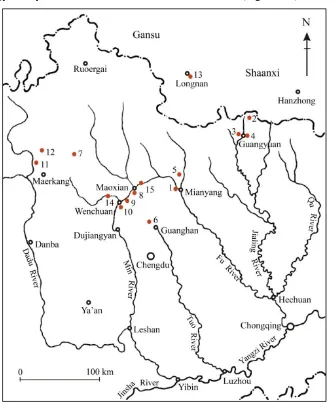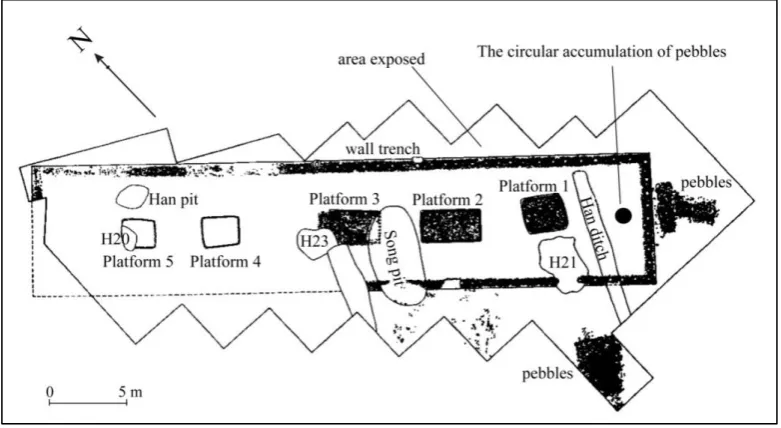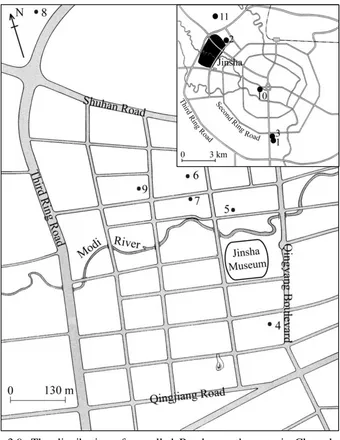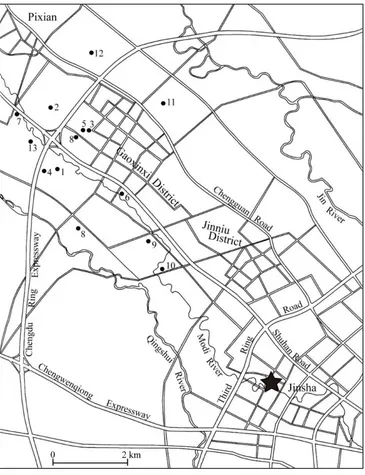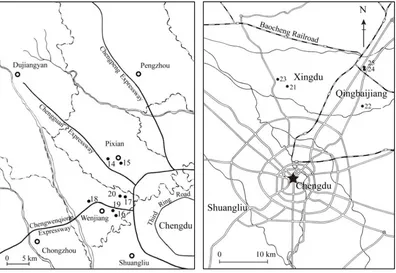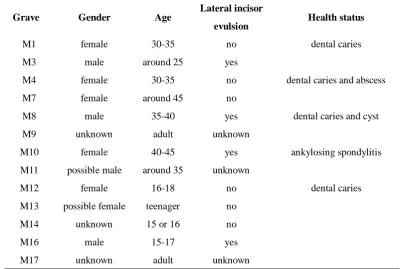Pottery Production and Social Complexity on the Chengdu Plain,
Sichuan, China, 2500 to 800 BC
by
Po-yi Chiang
A thesis submitted for the degree of Doctor of Philosophy
School of Archaeology and Anthropology
The Australian National University
ii
Declaration
I certify that this thesis is my own research.
Materials published by other scholars are referred to in the text.
iii
Acknowledgements
To complete this thesis I am grateful to several individuals and institutions
for their encouragement and support. My deepest gratitude goes first and foremost
to my supervisor Peter Bellwood. He patiently granted me the freedom to find my
research topic. Throughout my academic program, he not only motivated me to
conceive and develop the main ideas of thesis but also took much time out of his
already busy schedule in critically reading every draft, discussing my developing
ideas with me, and meticulously correcting my prose. His healthy skepticism, eye
for detail and wealth of knowledge are qualities I hope someday to be able to
emulate. I would also like to thank my supervisory panel members, Aedeen
Cremin and Matthew Spriggs, who gave me valuable suggestions and helped to
shape the final version of thesis.
My intellectual debts can also be traced to Noel Barnard. His doubts over the
accepted date of the Sanxingdui artefact pits K1 and K2 inspired me to review this
debated issue critically, to revise the archaeological chronology of the Chengdu
Plain between 2500 and 800 BC, and to challenge the widely accepted perspective
that the Sanxingdui culture was a Bronze Age culture. In the initial stages of my
thesis writing, he provided me with a great deal of advice about conducting
research on several aspects of prehistoric Sichuan, and kindly shared his
manuscripts and rare books with me.
This thesis could not have been written without the generosity of several
scholars. I am especially indebted to Jiang Zhanghua, Zhou Zhiqing, Zhang Qing,
He Kunyu, Liu Jun, Yang Zhanfeng from the Chengdu Municipal Institute of
iv
Sichuan Provincial Institute of Cultural Relics and Archaeology; Li Yongxian, Lu
Hongliang from Sichuan University; and Chiou-Peng Tzehuey from the
University of Illinois at Urbana-Champaign. Without their help, my fieldtrip in
Chengdu and petrographic observations of pottery thin-sections could not have
been successful. Special thanks go to Dong Jing from the Sanxingdui Museum
who advised me of valuable recent information concerning the Sanxingdui walled
settlement and spent a large amount of time with me during my visit to the
Sanxingdui settlement complex.
I would also like to express my heartfelt gratitude to Li Kuangti from the
Institute of History and Philology, Academia Sinica in Taiwan, who sparked my
interest in stepping into the archaeological field while I was an undergraduate
student in the Department of Economics, National Tsing Hua University. I am
greatly indebted to him for getting me interested in the archaeology of China, and
for encouraging me to apply for graduate studies at the Australian National
University. Also, I am grateful for his multi-faceted support throughout my
academic career. Many thanks also to Chen Wenshan from the Department of
Geology, National Taiwan University, who kindly advised me about thin-section
petrography and generously afforded me the use of equipment in his office. He
also provided me with timely advice both in academic and personal life. I learned
a lot from him.
I would like to thank the Australian National University, Chengdu Municipal
Institute of Cultural Relics and Archaeology, Sichuan Provincial Institute of
Cultural Relics and Archaeology, and the Department of Archaeology in Sichuan
University for their research infrastructure that allowed this thesis to be written.
My thanks are also due to the Ministry of Education, Republic of China, and the
v the first half of my academic program.
My appreciation also goes to other ANU staff and an amazing community of
friends in Canberra, Chengdu and Taipei, who have been helpful and encouraging
during various stages of my research: Doreen Bowdery, Liz Walters, Darrell
Dorrington, Li Zhiwen, Liang Jingfang, Qi Qi, and Yang Bei. In addition, words
cannot express my gratitude to Qi Yu for her constant support and being a friend
and partner throughout these years.
Finally, I am fortunate to have a family that supports me in all my
endeavours. They have been sources of inspiration, love, encouragement and
support. I owe special thanks to my parents for all of their patience and tolerance.
vi
Abstract
The goal of this research has been to examine potential changes in pottery
production between 2500 and 800 BC on the Chengdu Plain of Sichuan, China,
with a central focus on any relationships that might have existed between
organization of pottery production and degree of social complexity. The
evolutionary model of pottery production outlined by Rice (1981) is tested against
archaeological data from the Chengdu Plain, covering pottery manufacturing
technology and fabric composition, combined with a usage of metric indices to
investigate degrees of standardization.
In this research, the most commonly accepted chronology for the Chengdu
Plain between 2500 and 800 BC is first reviewed. Through an analysis of
available radiocarbon dates, archaeological stratigraphies, and the contrasting
distributions of the Sanxingdui and Shierqiao assemblages, I have suggested that
the Baodun culture existed between 2500 and 2000 BC, and was succeeded in
parallel by the Sanxingdui and Shierqiao cultures in the 2nd millennium BC.
This research also gives an introduction to significant sites on the plain and
reviews past archaeological research. Problems with the relative and absolute
dates of some sites are analysed. One of my conclusions is that the Bronze Age
commenced on the Chengdu Plain between ca. 1100 and 950 BC, rather than
during the earlier part of the 2nd millennium BC.
By synthesizing anthropological theories on the formations of social
inequality and states, combined with an analysis of mortuary data and available
protohistorical accounts, I propose an evolutionary model for the development of
vii
Table of Contents
Declaration ... ii
Acknowledgements ... iii
Abstract ... vi
Table of Contents ... vii
List of Figures ... x
List of Tables ... xv
Chapter 1 Research Background, Problem and Analytical Approach ... 1
1.1 Introduction ... 1
1.2 Ceramic studies in Western archaeology ... 1
1.3 The archaeological study of pottery in China ... 4
1.4 The research problem and procedures of analysis ... 10
1.5 Chapter summaries and sources of data ... 10
Chapter 2 The environmental and chronological setting of the ancient Chengdu Plain ... 13
2.1 The environmental setting of the Chengdu Plain ... 13
2.2 The Palaeoenvironments of the Chengdu Plain ... 14
2.3 The archaeological chronology ... 21
2.4 Problems generated by the Shierqiao radiocarbon dates ... 27
2.5 The problems raised by site distributions and chronology ... 33
2.6 The date of the early Shierqiao ... 35
2.7 Conclusions ... 41
Chapter 3 A review of past archaeological work concerning the Baodun, Sanxingdui and Shierqiao cultures on the Chengdu Plain ... 43
3.1 A review of past archaeological research on the Chengdu Plain ... 43
3.2 Chengdu Plain in the 3rd millennium BC – the Baodun culture ... 45
3.3 The walled settlements of the Baodun culture ... 53
Baodun ... 55
Yufucun ... 57
Gucheng ... 58
Mangcheng ... 60
Shuanghe ... 60
viii
Unwalled Baodun sites... 61
3.4 Chengdu Plain in the 2nd millennium BC ... 67
(a) Sanxingdui ... 67
The Yueliangwan terrace ... 73
The Xiquankan terrace area ... 75
The Sanxingdui location ... 77
The Qingguanshan terrace area ... 79
The Renshengcun cemetery... 81
The Cangbaobao terrace area ... 82
Sanxingdui artefact pits K1 and K2 ... 84
(b) Other Sanxingdui sites on the Chengdu Plain ... 89
(c) Early Shierqiao sites around Chengdu ... 92
3.5 Chengdu Plain between 1000 and 800 BC ... 95
Shierqiao and Xinyicun ... 95
The Jinsha site cluster ... 101
Sites northwest of Chengdu ... 109
The Zhuwajie bronze hoards and Qinglongcun... 112
Shaxi ... 117
3.6 Summary and Discussion ... 120
Chapter 4 Social Complexity on the Chengdu Plain between 2500 and 800 BC ... 124
4.1 Social complexity ... 124
4.2 Social Complexity on the Chengdu Plain ... 126
4.3 Textual sources on the Chengdu Plain during the first millennium BC ... 127
4.4 The rise of complex societies on the Chengdu Plain ... 132
4.5 An evolutionary model for the rise of complex society on the prehistoric Chengdu Plain ... 135
4.6 Mortuary Analysis on the Development of Social Stratification . 141 4.7 Analysis of grave sizes ... 157
4.8 Analysis of grave contents ... 162
4.9 Correlation between grave size and grave contents ... 167
4.10 Conclusion ... 170
Chapter 5 Pottery production on the Chengdu Plain between 2500 and 800 BC ... 171
5.1 Organization of craft production and social complexity ... 172
5.2 Craft specialization and standardization ... 174
ix
5.4 Discussion ... 189
5.5 Petrography and point count analyses ... 191
5.6 Petrographic observations ... 193
5.7 Statistical analysis of the proportion of non-plastics inclusions . 212 5.8 Discussion ... 217
5.9 Metrical analysis ... 221
5.10 Discussion ... 235
5.11 Conclusions ... 237
Chapter 6 Conclusions and future perspectives ... 239
6.1 Conclusions and considerations for future research ... 239
6.2 Some final considerations ... 243
Chinese glossary ... 246
x
List of Figures
Figure 2.1: The geographic boundaries of the Chengdu Plain, which is drained by
the tributaries of the Min and Tuo rivers ... 14
Figure 2.2: Locations of pollen cores ... 16
Figure 2.3: Small flat-based guan from Sanxingdui phase 3. ... 23
Figure 2.4: Ceramic ladles with bird-shaped handles with a hooked beak from Sanxingdui phase 3. ... 23
Figure 2.5: Tripodal he vessels from Sanxingdui phase 3. ... 24
Figure 2.6: High stemmed dou from Sanxingdui phase 3. ... 24
Figure 2.7: Ceramic lid from Sanxingdui phase 3. ... 24
Figure 2.8: ∞-shaped handles on lids from Sanxingdui phase 4. ... 25
Figure 2.9: Pointed-based zhan from Sanxingdui phase 4. ... 25
Figure 2.10: Pointed-based bei from Sanxingdui phase 4 ... 25
Figure 2.11: Probability distributions of the dates relating to the Baodun phase. . 32
Figure 2.12: Probability distributions of the dates relating to the Sanxingdui phase. ... 32
Figure 2.13: Probability distributions of the dates relating to the Shierqiao phase. ... 33
Figure 2.14: The author’s revised chronology of the prehistoric Chengdu Plain. . 42
Figure 3.1: The distribution of sites in western and northern Sichuan ... 46
Figure 3.2: Wide-diameter guan with notched lips from Guiyuanqiao ... 49
Figure 3.3: Narrow-necked flask rim sherds with external flanges from Guiyuanqiao, Anxiang, Konglongcun and Guannaruo ... 51
Figure 3.4: Three possible routes of rice farming dispersal into the Sichuan basin. ... 53
Figure 3.5: Distribution of the eight known Baodun walled settlements on the Chengdu Plain. ... 54
Figure 3.6: Section profile of the west wall of test trench T1 through the north wall of the Baodun walled settlement near Zhenwuguan ... 55
Figure 3.7: Plan of Baodun... 56
Figure 3.8: Plan of house F5 at Gucheng ... 59
Figure 3.9: The distribution of unwalled Baodun settlements in Chengdu City ... 62
xi
Figure 3.12: Map of Sanxingdui ... 68
Figure 3.13: Hangtu layers within the Yueliangwan wall and the sloping outer face ... 72
Figure 3.14: The locations of past excavations on the Yueliangwan terrace at Sanxingdui ... 74
Figure 3.15: A ceramic roof tile discovered in Yueliangwan terrace. ... 75
Figure 3.16: Two kneeling human stone statuettes from Xiquankan... 76
Figure 3.17: Kneeling stone statuettes with their hands tied at their backs from Fangchijie and Jinsha ... 76
Figure 3.18: Past excavations at the Sanxingdui location proper ... 77
Figure 3.19: Plan of the Sanxingdui phase 1 and 2 houses discovered in Sanxingdui zone III in 1980-81 ... 78
Figure 3.20: An aerial view of Qingguanshan house F1 ... 80
Figure 3.21: The postholes of Qingguanshan F1 were filled with burnt pebbles .. 80
Figure 3.22: The Renshengcun cemetery ... 81
Figure 3.23: Renshengcun graves M23 and M18 ... 82
Figure 3.24: Three Cangbaobao rectangular bronze ornaments. The one in the middle has turquoise inlay... 83
Figure 3.25: Possible Sanxingdui sites in Guanghan and Shifang counties. ... 89
Figure 3.26: Distribution of sites believed to be of Sanxingdui date in and northeast of Chengdu ... 91
Figures 3.27 and 3.28: A bird’s-head shaped wooden artefact and an owl’s-head shaped pottery figurine from Sanxingcun ... 92
Figure 3.29: Two owl’s-head shaped pottery figurines from Sanxingdui. ... 92
Figure 3.30: Archaeological sites reported to contain early Shierqiao deposits ... 94
Figure 3.31: The locations of Shierqiao and Xinyicun in Chengdu City. ... 96
Figure 3.32: Plan of Shierqiao excavation ... 96
Figure 3.33: Suggested chronological seriation of the Shierqiao and Xinyicun layers. ... 97
Figure 3.34: Distribution of early to middle Warring States burial sites in and around Chengdu City ... 99
Figure 3.35: Similar pointed-based zhan from Sanxingdui pit K1 and Shierqiao layer 12 ... 100
Figure 3.36: The Jinsha site cluster ... 102
Figure 3.37: A stratigraphic seriation of the Jinsha site cluster. ... 103
Figure 3.38: Log coffin burials M470 and M182 at Wanbo... 106
Figure 3.39: Log coffin burial M917 at Guoji huayuan ... 106
xii
Figure 3.41: Log coffin burial M8 at Shangyejie ... 107
Figure 3.42: Distribution of Shierqiao sites along the Qingshui and Modi rivers ... 110
Figure 3.43: The stratigraphic succession of the sites northwest of Chengdu. ... 111
Figure 3.44: 5 bronze lei from Zhuwajie hoard 1 ... 113
Figure 3.45: Two bronze zhi vessels with basal inscriptions reading ‘tanfugui’ and ‘muzhengfuji’, and a bronze zun from Zhuwajie hoard 1 ... 113
Figure 3.46: 4 bronze lei from Zhuwajie hoard 2 ... 114
Figure 3.47: Similar rhomboid paddle-impressions on Zhuwajie and Qinglongcun sherds... 115
Figure 3.48: Shouldered stone axes and hoes from Shaxi... 118
Figure 3.49: Regions in Yunnan where tanged stone axes like those of Shaxi occur. ... 119
Figure 4.1: Summaries of grave size distribution. ... 158
Figure 4.2: Graphs to show the relationships between grave size, and abundance and variability of grave goods. ... 167
Figure 5.1: The type B kiln excavated at Xicheng tianxia ... 178
Figure 5.2: The type B kiln excavated at Sanhe huayuan ... 179
Figure 5.3: The type A kiln excavated at ‘Laboratory Building of Qingshuihe Campus, UESTC’ ... 179
Figure 5.4: The type A kiln excavated at Zhixin Jinshayuan Phase I ... 181
Figure 5.5: The type A kiln excavated at Guiyuanqiao ... 182
Figure 5.6: Two connected pits (structure K7) with cobbles excavated at Guiyuanqiao ... 182
Figure 5.7: The top view and side views of a possible type A kiln excavated at Sanxingdui ... 183
Figure 5.8: The type B kiln excavated at Zhonghai guoji Commune site 2 ... 184
Figure 5.9: The type B kiln excavated at Minjiang xiaoqu ... 184
Figure 5.10: The ceramic stamp unearthed at Zhengyincun ... 185
Figure 5.11: The ceramic stamps with fin-shaped handles unearthed at Sanguancun and Huachengcun ... 186
Figure 5.12: Flat stone discs exhibited in Jinsha site Museum. ... 187
Figure 5.13: Two flat stone discs excavated at Zhengyincun and Meiyuan Northeast in Jinsha ... 187
Figure 5.14: Stone discs with circular drill marks. ... 188
Figure 5.15: Stone discs in situ at Meiyuan Northeast ... 188
Figure 5.16: Presumed large bi disc recovered at Sanxingdui. ... 189
xiii
Figure 5.18: The stage with an attachment that allows the thin-section to be
moved in fixed increments. ... 192
Figure 5.19: A binocular polarising optical microscope is connected with a computer system that allows photomicrographs to be digitally displayed on the screen. ... 193
Figure 5.20: Cord-marked guan with notched rims ... 202
Figure 5.21: Ring-footed zun with dished rim and horizontal flared rim ... 203
Figure 5.22: Wide-lipped and flat-based weng ... 203
Figure 5.23: Tubular lid handles from Zhonghai guoji Commune site 2. ... 203
Figure 5.24: Long-necked and flat-based guan ... 204
Figure 5.25: Pedestal-shaped pot support ... 204
Figure 5.26: Lipped guan rims and two examplesfrom Guoji huayuan, Jinsha . 205 Figure 5.27: Lipped weng rims and an example from Guoji huayuan, Jinsha .... 206
Figure 5.28: Long-necked gui rims and an example from Guoji huayuan, Jinsha ... 206
Figure 5.29: Thin-section micrographs of a large grain of monocrystalline quartz, Guoji huayuan 006 and 005... 208
Figure 5.30: Thin-section micrographs of large feldspar grains, Guoji huayuan 005 and Sanxingdui 005 ... 208
Figure 5.31: Thin-section micrographs of a large granite fragment, Guoji huayuan 005... 208
Figure 5.32: Thin-section micrographs of an amphibole grain, Guoji huayuan 005. ... 209
Figure 5.33: Thin-section micrographs of a grain of fine schist, Baodun 005. ... 209
Figure 5.34: Thin-section micrographs of a pyroxene grain, Baodun 005. ... 209
Figure 5.35: Thin-section micrographs of muscovite mica, Guoji huayuan 007. 210 Figure 5.36: Thin-section micrographs of biotite mica, Baodun 004. ... 210
Figure 5.37: Thin-section micrographs of a piece of slate, Guoji huayuan 005.. 210
Figure 5.38: Thin-section micrographs of iron-rich concretions, Meiyuan Northeast 005. ... 211
Figure 5.39: Thin-section micrographs of a large sand clast, Meiyuan Northeast 005... 211
Figure 5.40: Thin-section micrographs of Sanxingdui fine pottery, dominated by silty sands. ... 211
Figure 5.41: Rim and base sherds of pointed-based zhan unearthed at Lanyuan, Jinsha. ... 218
Figure 5.42: Rim sherds of lids unearthed at Sanhe huayuan, Jinsha. ... 219
xiv
Plain. ... 223
Figure 5.44: Type 1 zhan from Sanxingdui pit K1and Qingjiangcun ... 223
Figure 5.45: Carinated type 1 zhan from Shierqiao layer 12 ... 224
Type 5.46 Type 2 zhan from Sanxingdui pit K1 ... 224
Figure 5.47: Type 2 zhan from Sanxingdui pit K1 ... 224
Figure 5.48: Type 3 zhan from (A) Sanhe huayuan, (B) Dafucun, (C) Furongyuan South, and (D) Xinyicun ... 225
Figure 5.49: Type 4 zhan from sites of (A) Lanyuan, (B) Sanhe huayuan, (C) Xinhelu xiyanxian, and (D) Wanbo ... 226
Figure 5.50: Type 5 zhan from (A) Datang Telecommunication Phase II and (B) Xinyicun ... 226
xv
List of Tables
Table 2.1: Radiocarbon dates from Chengdu Plain, Baodun to Shierqiao phases 28
Table 2.2: Chengdu Plain sites which include both Baodun and Shierqiao cultural
deposits ... 36
Table 2.3: Archaeological sites reported to contain early Shierqiao deposits. ... 38
Table 3.1: Radiocarbon dates from Yingpanshan ... 48
Table 3.2: Dental observations on 13 skeletons from Shijiefang. ... 65
Table 3.3: Varying opinions on Baodun phase chronologies ... 66
Table 3.4: Archaeological contexts in and around Sanxingdui ... 68
Table 3.5: The 1980-86 chronological seriation for Sanxingdui ... 88
Table 3.6: Archaeological sites reported to contain early Shierqiao deposits. ... 93
Table 3.7: Summary of the opinions of Chinese archaeologists on the chronologies of early Shierqiao and Xinyicun cultural layers. ... 98
Table 3.8: Excavated site numbers on the Chengdu Plain from site reports published during the last 80 years. ... 120
Table 4.1: Mortuary data by grave in Chengdu Plain sites between 2500 and 500 BC ... 144
Table 4.2: Numbers of graves and sites with graves on the prehistoric Chengdu Plain. ... 157
Table 4.3: Grave sizes and standard deviations through time. ... 161
Table 4.4: Percentages of graves with offerings in groups A to F. ... 163
Table 5.1: Published prehistoric ceramic kilns excavated on the Chengdu Plain ... 179
Table 5.2: Thin-section pottery samples subjected to petrographic analysis ... 194
Table 5.3: The results of petrographic point counting ... 198
Table 5.4: CV analysis of numbers of non-plastics plus voids in thin-sections of 19 dated pottery vessel types ... 213
Table 5.5: Metrical data for the 6 types of pointed-based zhan... 227
Table 5.6: Average mouth diameters and vessel heights of the 6 types of zhan.. 233
1
Chapter 1
Research Background, Problem and Analytical Approach
1.1 Introduction
Pottery as a general artefact serves nearly all members of those societies that
are accustomed to its usage. It was made in many geographic areas over long time
spans (Barnett and Hoopes 1995; Kuzmin 2006, 2010; Rice 1999), and played a
critical role in many social and economic contexts (Howard and Morris 1981;
Kolb and Lackey 1988; Sinopoli 1991:83-160; van der Leeuw and Pritchard
1984). Because of its abundance and its diverse and nearly imperishable nature,
once fired to a sufficient temperature, pottery is also one of the most important
sources of information for archaeologists (Braun 1983:108; Matson 1995:108;
Rye 1981:121-2).
Archaeologists have traditionally used pottery to elucidate aspects of the past,
such as constructing chronologies, identifying style zones and boundaries,
investigating exchange systems, and understanding craft technology. However,
there remain great discrepancies in the research objectives and theoretical
approaches adopted by Euro-American and Chinese archaeologists (Underhill
2002a), owing to their divergent backgrounds of academic thought. From this
comparative theoretical perspective, this thesis studies the diachronic changes in
the pottery made and used by the archaeological cultures of the Chengdu Plain in
Sichuan, China, between 2500 and 800 BC.
1.2 Ceramic studies in Western archaeology
2
pottery for its own sake in the West can possibly be traced back to the 16th century,
when Capriano Piccolpasso reviewed the ceramic technology in use during the
Italian Renaissance. More advanced and scientific studies on pottery were
appearing by the mid to late 19th century, for instance, Alexandre Brougniart’s
work Traité des arts céramiques, Anatole Bamps’ microscopic analyses of
Peruvian ceramics, William H. Holmes’ analyses of Chiriqui pottery
manufacturing techniques and decoration in Colombia, and Erland Nordenskiold’s
petrographic thin section analyses of sherds from Mesa Verde in Colorado.
Excluding Holmes, a geologist turned archaeologist, the others had no
archaeological training.
With the rapid progress of archaeological fieldwork and research in the early
20th century, ceramic studies by Euro-American archaeologists increased in
number. However, most early examples focused on reconstructing past pottery
making methods and devising typological classifications in order to create relative
archaeological chronologies (Kolb 1989a, b). In view of this situation, Shepard
(1936:389; 1956:III-XIX) and Sayce (1933), according to the accounts by Bishop
(1991) and Matson (1982:23), called for a better integration of ceramic
technology within the larger behavioral context.
Aside from Shepard’s own contribution on the integration of scientific
analytical data with archaeological context (Morris 1974; Thompson 1991),
ceramic archaeological theory also benefited greatly from research in the
American Southwest. Here, Frederick R. Matson proposed his concept of
‘ceramic ecology’ in pottery analysis in 1961, intended to enhance the
communication between archaeologists and ceramic technologists (Matson
1965:1-19; Borza 2008; Kolb 1988:1-37; Kramer 1985:78). Ceramic ecology may
3
attempts to relate ceramic raw materials and manufacturing technology to the
function of pottery within the specific cultural context.
According to Rice (1987:314),
Ceramic ecology is a contextual approach to ceramic analysis that seeks to place technical data into both an ecological and sociocultural frame of reference by relating the technological properties of the local resources to the production and use of the ceramic products. Ceramic ecology, like general cultural ecology, begins with studying the ceramic environment – local resources used in pottery making – as well as with describing the ecological and climatological features that might impinge on potters.
This quotation not only summarises Matson’s earlier thinking but also reflects his
critique of the once-prevalent phenomenon of publishing descriptive accounts of
technological pottery data isolated within archaeological reports (Kolb 1988,
1989b; Matson 1951, 1984; Rice 1987:328). He urged greater attention to the
ethnographic literature related to pottery making and use, and to
archaeologically-oriented ethnographic research design.
The impact of ceramic ecology was overshadowed by the surging popularity
of ceramic ethnoarchaeology in the late 1960s and 1970s (Longacre 1991; M.
Stark 2003), although a number of key publications during the 1980s by Rice
(1984), van der Leeuw and Pritchard (1984), Kolb and Lackey (1988), and Kolb
(1988, 1989), served to keep the field of ceramic ecology alive and well.
Archaeologists realized that pottery was in effect a tool that contributed to the
functioning of past societies (Braun 1983), and tended to pay less attention to
typological classification and cultural-historical reconstruction for their own sakes,
and more to past processes of pottery creation and use within the social context
4
Today, ceramic ethnoarchaeology along with new scientific methods for
analysing sherds such as petrographic thin section analysis, firing temperature
analysis, X-ray diffraction, X-ray fluorescence spectroscopy and neutron
activation analysis (Rice 1987:371-446), have allowed archaeologists to build
stronger inferences about locations of production, technological choices, vessel
functions, and aspects of distribution and social organization (for example, D.
Arnold 1985, 1991; P. Arnold 1991a, 2000; Costin 2000; Deal 1998; Hegmon
2000; Kramer 1985; Longacre 1991; Roux 2003; Skibo 1992; M. Stark 1991a, b,
1995, 2003; Underhill 2003). Nevertheless, culturally particularistic case studies,
known as ‘cautionary tales’ (D. Arnold 1991:323), always exist and disturb
straightforward analogies between the ethnographic record and archaeological
contexts (D. Arnold 1991; Bowser 2000; Hegmon 2000). For example, a sharp
change in pottery style need not be a result of a demographic shift or migration,
but can also reflect commercialization and demand. Similarly, homogeneity in
vessel shape need not imply specialized production, but may also reflect market
preferences. Many processes of pottery production, distribution and consumption
need to be comprehended in more complex ways.
1.3 The archaeological study of pottery in China
Modern archaeology in China commenced in the early 20th century (Chang
Kwangchih 1986:12-21; Chen Xingcan 1997:15-22), and studies of pottery also
became central foci of research. The academic development of archaeology in
China has differed greatly from that of the West because, until recently, it has been
fundamentally historiography-oriented (Chang Kwangchih 1981; Du Jinpeng
1996; Falkenhausen 1995:213-5; Olsen 1987; Su Bingqi 1991). Compliance with
5
to create an abiding theoretical framework for cultural evolution. This tended to
impede analytical research on ceramics (Chang Kwangchih 1981, 1992; Nelson
1995:4-7; Tong Enzheng 1995). In addition, the political uncertainty of the
Sino-Japanese War between 1937 and 1945, the following civil war until 1949,
and the Cultural Revolution from 1966 through 1976 also resulted in an unstable
academic environment, making research progress difficult (Li Liu 2012:1-16).
Two research categories currently dominate the study of pottery in Chinese
archaeology. They are typological study for chronological purposes, and studies of
potential interaction between archaeological cultures based on pottery variability.
Additional and important pottery studies include ethnoarchaeological observations
of pottery manufacture by ethnic minorities in southwestern China, especially
Yunnan, and today there are increasing instances of scientific analysis of sherd
compositions and residues.
The typological study of pottery has a long history in Chinese archaeology.
One of the earliest publications in English, Wu Jinding’s (1938) Prehistoric
Pottery in China, explicitly documented pottery excavated from Yangshao and Longshan contexts in terms of texture, surface decoration, wall thickness, mouth
diameter, and details of the base or support. Wu’s typological classification was
integrated with site stratigraphies to enable a seriation of the archaeological finds.
This Western-rooted method for relative dating of archaeological finds (Conkey
and Hastorf 1990; Harris 1989:7-13; O’Brien and Lyman 2002:23-58; Plog 1980)
was utilized extensively before the adoption of radiocarbon dating in China in
1965 (Institute of Archaeology, CASS 1983:306).
Today, typological classification of pottery remains the major goal for
archaeological reports in China. In sites without 14C datable materials, it still
6
Houxi (2012) on the western Chongqing sequence; Gao Guangren and Shao
Wangping (1981) on the chronology of Longshan gui-tripod vessels in northern China; Gao Tianlin (1996) and Su Bingqi ([1948]1984) on li-tripod vessels in the Yellow Valley; Song Zhimin (2005) and Sun Hua (1996) on the Chengdu Plain
sequence; Su Bingqi (1965) on Banpo and Miaodigou pottery. Yu Weichao (1987)
also gave a methodological introduction, and Yu Xiyun (2003) discussed cultural
transformations using pottery typology.
However, the major drawback of typological relative dating, to be further
discussed for the Chengdu Plain in Chapter 2 and 3, is that classifications by
different archaeologists can be inconsistent and ambiguous, depending upon
personal perceptions. This can be shown by examples from the Three Gorges
region (that part of Yangzi valley connecting Hubei and Chongqing), where a
series of salvage excavations have been conducted in the last 15 years by joint
archaeological teams from a number of Chinese provinces (Chen Zhenyu and
Wang Fengzhu 2003). Pottery vessels of similar morphology are given
inconsistent names by archaeologists from different provincial backgrounds, and
classifications often do not overlap coherently. A kind of vessel defined as a unity
by one archaeologist can be separated into two or three subtypes by another.
Moreover, the lack of pictorial illustration worsens the situation.
One of the major functions of pottery in Chinese archaeology is to assist the
identification of archaeological cultures, social boundaries, and directions of
social interaction (Li Boqian 2008). It has been used to study aspects of migration
(Du Jinpeng 1995; Li Boqian 1983; Xiang Taochu 2005, Zhang Chi 2009),
military conflict and acculturation (Luan Fengshi 1997; Wang Jin 1989; Yan
Wenming 1990), and trade as well as other facets of cultural contact (An Jinhuai
7
2010). For instance, the early Central Plain-centric diffusion model of Chang
Kwangchih (1963, 1977), the quxi-leixing (regional systems and local cultural series) model of Su Bingqi (1991, 1999:33-99; Su Bingqi and Yin Weizhang
1981), the more recent regional interaction sphere concept of Chang Kwangchih
(1986:241-2), and Yan Wenming’s (1987) idea of multiregional development all
intrinsically assumed that social boundaries were defined by changes in pottery
assemblages.
Sometimes, Chinese archaeologists have also correlated specific
archaeological cultures, as defined in part by pottery styles, with certain
proto-historic or early historic political or ethnic groups. For example, the Erlitou
culture in Henan and Shanxi has been associated with the legendary Xia Dynasty
(for example, Sun Hua 1980, Xiang Taochu 2011; Zou Heng 1980:95-182; but see
Qin Xiaoli 2003; Xu Hong 2004, 2009; Xu Hong and Liu Li 2009). The Neolithic
to Bronze-Iron Age archaeological cultures of southern and southwestern China
have been associated with the Yue, Pu and Qiang peoples of the southern and southwestern Yi recorded in some historical accounts (Liu Hong 1996). Today, this approach remains popular in Chinese archaeology, and few Chinese
archaeologists are familiar with Western ethnoarchaeological studies that claim
that pottery stylistic patterning does not always correlate well with social
boundaries (Bowser 2000; Gosselain 2000; Hegmon 1992: 522-4, 2000; M. Stark
1998; M. Stark et al. 2000, 2008; Sterner 1989). One important exception is Wang Ningsheng (2003), who has clearly pointed out the problem of past ethnic
identification based on pottery typology in Chinese archaeology.
Questions of chronology, origin, provenance, and manufacturing technique
are also of interest to Chinese archaeologists, and ethnoarchaeological
8
resolving some of these issues. A series of ethnoarchaeological pottery studies
carried out since the 1950s have explicitly recorded the pottery industries of the
Dai and Wa peoples in Yunnan, who speak Tai and Austroasiatic languages, as
well as those of many Han populations. These studies have covered resource
acquisition and preparation, vessel forming, finishing, drying, firing, organization
of production and distribution, and time and seasonal scheduling (Cheng Zhuhai
et al. 1986; JTDP 1977; Li Yangsong 1958, 1959; Wang Ningsheng 1989:190-210; Wang Yawen 2010; Yang Yuan 1986, 1987; Zhang Ji 1959). However, none have
established an anthropology-based research framework for dealing with
archaeologically excavated pottery. The ultimate goal of these studies was only to
understand prehistoric pottery making techniques from present-day observations
(Li Yangsong 1990).
Scientific analyses of archaeological pottery commenced in China as early as
the 1960s (Zhou Ren et al. 1964). The now-discredited technique of thermoluminescence dating was introduced and applied in the late 1970s and early
1980s (Wang Weida 1979; Wang Weida and Zhou Zhixin 1983), although only a
small number of microscopic and chemical analyses were conducted before 1990
(Li Jiazhi 1978; Yan Dongsheng and Zhang Fukang 1986:1). It was not until the
release of the policy for Sino-foreign collaborative research in archaeology in
1990 (SACH 1992), which reopened the door to foreign experts (Li Liu
2012:19-20; Murowchick 1997; Underhill 2002a:21), that a variety of scientific
methods were imported into China for sherd analysis. These included neutron
activation analysis (NAA), X-ray diffraction (XRD), X-ray fluorescence analysis
(XRF), energy-dispersive X-ray spectroscopy (EDX), electron probe micro
analysis (EPMA-WDS), and inductively coupled plasma atomic emission
9
Cheng Xiaolin et al. 2009; Flad et al. 2005; Hung Lingyu et al. 2011; Liu Fangxin
et al. 1993; Lu Xiaoke et al. 2012; Ma Qinglin and Li Xian 1991; Ma Qinglin et al. 2004; Min Ying et al. 2011; Wu Rui et al. 2005; Zhang Yi et al. 2012).
After 1990, scholarly exchange and collaborative projects between China and
foreign countries increased rapidly. Some research by western scholars has been
translated into Chinese; for example, Skibo and Deal (1995) on residue analysis;
Matson on ceramic ecology (1965, translated by Huang Yang et al. 2012); Rice’s
Pottery Analysis: A Source book (contents selected, abbreviated and translated by Zhou Likun 2011) and her evolutionary model of pottery production (Rice 1981,
translated by Guo Lusha and Chen Lizi 2014); Brown (1989, translated by Pan
Yan and Chen Hong 2011) on the beginnings of pottery making from an economic
perspective; and Roux (2003, translated by Fu Yongxu 2011) on quantifying
ceramic standardization and production intensity. Additionally, some Chinese
archaeologists (Dai Xiangming 2006, 2010; Sun Zhouyong 2008) are beginning to
adapt to the influence of the Euro-American tradition, examining craft production
by integrating perspectives in technology, ecology, economic organization,
political economy and exchange (for Euro-American examples, see Brumfiel and
Earle 1987; Clark and Parry 1990; Cobb 1996; Costin 1993, 2001; Costin and
Wright 1998; Hruby and Flad 2007; Wailes 1996; Flad 2011; Stein and Blackman
1993).
Similar research has been pioneered in China by Underhill (1990, 1991, 1996,
2002b, c) on Longshan pottery, investigating how systems of pottery production
evolved in relation to increasing cultural complexity, and how control of craft
production of prestige goods contributed to elite social power and status
consolidation. However, little attention was paid to such issues by Chinese
10
researches were published, even though Sun’s focus was on jade jue earring
production rather than pottery.
1.4 The research problem and procedures of analysis
The archaeological cultures located on the ancient Chengdu Plain between
2500 and 800 BC are termed the Baodun, the Sanxingdui and the Shierqiao. One
conspicuous pottery change which occurred after the termination of the Baodun
culture was the loss of its exquisite surface decoration. The high percentage of
fine wares that dominated the Baodun repertoire also decreased during Sanxingdui
and Shierqiao times, when coarse wares conversely dominated (Jiang Cheng and
Li Mingbin 1998; Jiang Zhanghua et al. 2001, 2002; Li Boqian 1997; Song Zhimin 2002; Wang Yi and Sun Hua 1999; Wang Yi and Zhang Qing 1999; Sun
Hua 2000:305-6). Based on my observations of archaeological collections of
Sichuan pottery deposited in research institutions and museums, there might also
have been a tendency towards increasing homogeneity in the sizes of specific
vessel types.
In this thesis, the possible impetus behind these pottery changes is examined
from the perspective of organizational change in production with increasing craft
specialization. I examine potential changes in the modes of pottery production
between 2500 and 800 BC on the Chengdu Plain, with a focus on the development
of otherwise of specialized production over time, and relationships between the
organization of pottery production and the degree of social complexity.
1.5 Chapter summaries and sources of data
In the following six chapters, chapter 2 firstly defines the geographical
11
of this research. It discusses available palaeoenvironmental data relevant for the
late Holocene, and also examines the chronology for this region as constructed by
Chinese archaeologists. One of my suggestions is that the Sanxingdui and the
Shierqiao were partially contemporary rather than successive archaeological
cultures. In addition, this chapter also suggests that the common pointed-based
pottery vessels used as index fossils for the recognition of the Sanxingdui and
Shierqiao cultures require a reassessment.
Chapter 3 inventories past excavations of archaeological sites dating between
2500 and 800 BC on the Chengdu Plain, and introduces the main sources of
archaeological material used throughout this dissertation - settlements, burials and
excavated artefacts. The aim of both chapters 2 and 3 is to construct an
archaeological foundation for understanding the sociopolitical developments on
the ancient Chengdu Plain that are discussed further in Chapter 4. Settlement data
from the Sichuan Plain were found to be lacking sufficient detail to allow any
strong conclusions about demography and social complexity, but chapter 4
formulates a model to explain sociopolitical development on the Chengdu Plain
between 2500 and 800 BC using a synthesis of burial data and historical records,
followed by an examination of anthropological theories on the formation of social
inequality and states. This model suggests that the mode of subsistence and
material culture production would have altered from a household-focused
economy to one based more on economic specialization in order to meet
increasing market demands consequent on sociopolitical consolidation and
population increase.
Chapter 5 examines the prehistoric pottery industry of the Chengdu Plain in
detail, approaching technological issues through petrographic thin sections of
12
in site reports. This analysis goes to the heart of the major research problem of
this thesis, discussing issues connected with the development of craft
specialization. The sherds used for thin-section petrography were provided by the
Sanxingdui workstation and the Chengdu Municipal Institute of Cultural Relics
and Archaeology. All are excavated finds with detailed recorded contexts.
However, since the sample sizes made available to me in these institutions were
quite small, the conclusions that follow should be considered as hypotheses
guiding future studies.
In this thesis I review the Chinese language sources, including the collected
reports published by the Chengdu Municipal Institute of Cultural Relics and
Archaeology (CMICRA 2001, 2002, 2003, 2004, 2005a, 2006a, 2007a, 2008,
2009a, 2010, 2011, 2012, 2013); the Sichuan Provincial Institute of Cultural
Relics and Archaeology (SPICRA 1998); and a number of independently
published reports of important excavations including Chengdu Shierqiao
(SPICRA and CMICRA 2009), Jinsha taozhen (CMICRA and SAMBU 2002),
Sanxingdui Sacrificial Pits (SPCIRA 1999), and Chenggu Baoshan (CAMNU 2002). I also examine data published in three major Chinese archaeological
journals: Kaogu, Wenwu, and Kaogu xuebao. As well as the above, I also refer to information contained in historical texts such as Shuwang benji (Basic Annals of the Shu Kings) and Huayang guozhi (The History of Huayang) (Liu Lin 1984). These sources refer to data relevant for the study of social change on the ancient
13
Chapter 2
The environmental and chronological setting of the ancient Chengdu Plain
2.1 The environmental setting of the Chengdu Plain
Situated between latitudes 29.5° and 32°N, and between longitudes 103° and
104°E, the Chengdu Plain is a down-faulted basin that formed initially at the
beginning of the Quaternary. The Min and upper Tuo rivers have been flowing
through it and depositing alluvium since at least the middle Pleistocene (780-130
ka BP) (Fu Shun 2006:31; Qian Hong and Tang Rongchang 1997). The western
boundary of the basin is formed by the Longmen and Qionglai ranges that form
the eastern fringe of the Qinghai-Tibet Plateau and rise to around 1500 to 3000 m
above sea level. The eastern edge of the plain is formed by the northeast to
southwest oriented Longquan mountain range, the watershed between the Min and
Tuo rivers, which rises to around 700 to 1000 m. In the northwestern portion of
the plain, Dujiangyan city lies at 750 m above sea level, while Chengdu to the
southeast lies at 500 m. Fifty km south of Chengdu City, the plain drops at a grade
of 3° to 4° to 200 m above sea level (Li Jun et al. 2005).
Generally speaking, the physical boundaries of the Chengdu plain have two
definitions. The greater one refers to the total area enclosed within the above
mountain ranges and some low hills located in the south and the northwest of the
Sichuan basin, between roughly Mianyang city in the north and Leshan city in the
south. The more significant one for this thesis refers to the fan-shaped alluvial
plain that measures around 7340 km² and includes the cities and counties around
Chengdu City, including Guanghan, Pengzhou, Jintang, Deyang, Shifang, Pixian,
14
[image:30.595.88.481.106.416.2]Chengdu plain refers to the latter definition (Figure 2.1).
Figure 2.1: The geographic boundaries of the Chengdu Plain, which is drained by
the tributaries of the Min and Tuo rivers (redrawn after Zhu Zhangyi et al. 2006, with modifications).
2.2 The Palaeoenvironments of the Chengdu Plain
The Chengdu Plain has a monsoon-influenced wet subtropical climate. The
Qinling ranges to the north shield it from cold Siberian winds, and snow is rare.
The annual mean temperature is 16-17°C, and annual precipitation averages
900-1300 mm. Rainy days average 300 days each year, with most rain falling in
summer and autumn (SZX 1980:8-20).
However, the environment today need not reflect past conditions with
precision, even though the palaeoclimate of the subcontinental area that comprises
modern China has always been strongly affected by the Asian monsoon (Winkler
15
varied in intensity (An Zhisheng 2000; An Zhisheng et al. 2000). By 7000 BC, following the climatic amelioration after the last glacial maximum, temperatures
had become 1-3°C warmer than present (Winkler and Wang 1993). The
mid-Holocene climatic optimum then lasted between 6500 and 1000 BC (Shi
Shaohua 1993; Shi et al. 1993), meaning that the earlier part of the time span covered in this thesis occurred in a period of relatively warm climate.
Climatic fluctuations in the Sichuan basin have been similar to those in East
Asia generally (An Zhisheng et al. 2000; Liu Xingshi 1983, 2005; Shi Shaohua 1993), with a relatively temperate and arid period on record between 7500 and
5500 BC, a warmer and moister period between 5500 and 3000 BC, and then
progressive cooling between 3000 and 700 BC (Li Jun et al. 2005).
Proxy data illuminating more precise details of the palaeoenvironment of the
Chengdu Plain in the early Holocene remain scarce. Based on the Shierqiao spore
and pollen record (SPICRA and CMICRA 2009:223-30), a large-scale early
Holocene retreat of cold-resistant coniferous tree genera, such as Pinus, Tsuga, Picea and Abies, was matched by a spread of mesic fern genera such as
Hymenophyllum and Pteris, as well as species of Polypodiaceae and Polypodium. The temperature during the early Holocene was slightly cooler than now, but a
progressive warming trend after 5500 BC is attested by pollen cores from Ziyang
city, Zizhong county, and another from Zigong city in the southern Sichuan basin,
16
Figure 2.2: Locations of pollen cores: Ziyang (1), Zizhong (2), Zigong (3),
Mianning (4), Leibo (5), Butuo (6).
Radiocarbon-dated between 5500 and 4740 BC, the Ziyang core contained
subtropical plants, such as Keteleeria, Castanea, Pterocarya, palms, and tropical ferns. The annual mean temperature during this period is estimated to have been
about 3°C higher than now (Duan Wanti et al. 1981, cited in Winkler and Wang 1993). The cores from the other two river terrace sites in Zizhong and Zigong,
dated between 4700 and 4400 BC, contain subtropical species dominated by
Juglandaceae, Ginkgoaceae, and tropical ferns. These records also suggest an existence of subtropical broadleaf forest at this time (Duan Wanti et al. 1981, cited in Lan Yong 1993, Zhu Shiguang 1988).
Other data that identify palaeoclimatic oscillation in the early Holocene come
from Lake Shayema in Mianning county in mountainous southwestern Sichuan,
about 2400 m above sea level and 320 km southwest of Chengdu City (Figure 2.2).
[image:32.595.129.438.74.341.2]17
monsoons, the Shayema core indicates that southwestern Sichuan was warm and
moist between 7100 and 5800 BC, and glacial era cold-tolerant genera such as
Abies, Betula and deciduous oaks were progressively replaced by humid climate genera such as Tsuga and Cunninghamia. Also present by this time were evergreen oaks and other deciduous genera, including Celtis, Fagus, Rhus, Euptelea, Liquidambar, Morus, Cercidiphyllum, Nyssa and Euonymus.
The relative abundance of deciduous plants in the Shayema core suggests a
warmer climate than now, with less seasonal precipitation. The pollen record from
Shayema between 5800 and 2000 BC then suggests a transition from the previous
warm and wet period into a pattern of strongly seasonal rainfall and a decreased
range between summer and winter temperatures (Jarvis 1993; Liu Helin and Wang
Deyin 1982, 1984). A similar change occurs in other parts of southwestern
Sichuan (Tang Lingyu and Shen Caiming 2000), especially at Lake Yihai in
Mianning county (Ai Nanshan 2002; Li Zhengji 1986), Lake Xiaohaizi in Leibo
county (Liu Helin et al. 2004), and Lake Huolie in Butuo county (Liu Helin et al.
2003) (Figure 2.2).
A progressive warming trend between 8000 and 4000 BC can also be
inferred from high-resolution pollen cores drilled in Guanghan. These indicate
that broadleaf forests dominated by Quercus and evergreen broad-leaved trees were dominant on the Chengdu Plain by 4000 BC (Fu Shun 2002:12). However,
by this time the climate was already starting to become drier. For instance,
calculations of precipitation and air temperature from a pollen core drilled near
the Jing river in Chengdu City suggest an annual precipitation of less than 800
mm prior to 2500 BC (Luo Lunde 1996). The formation of the Jiangbei
conglomerate within the Sichuan basin between 5500 and 2500 BC, with its high
18
aridity by this time because sedimentary gravels of this sort form only under
conditions of low precipitation (Ai Nanshan 2002; Liu Xingshi 1998).
According to Luo Lunde (1996), annual precipitation after 2500 BC
increased but the annual mean temperature between 2500 and 1000 BC dropped.
The Guanghan core confirms a similar pattern (Fu Shun 2002:12), suggesting that
the increasing precipitation apparently accelerated the formation of the Chengdu
alluvial floodplain before 1700 BC (Fu Shun 2006:23-4). Clay mineral, organic,
free iron oxide and organic carbon-isotope compositions of Jinsha soils suggest
that the Chengdu Plain climate started to oscillate between cold/dry and
warm/moist conditions after 2000 BC, with a cold and dry interval between 2000
and 1800 BC, a warmer and less dry interval between 1800 and 1450 BC, and
then a warmer and wetter interval between 1450 and 1150 BC (Chen Bihui et al.
2003; Fu Shun 2006:61-2; Luo Hong et al. 2007; Luo Liping et al. 2007).
It remains unclear whether the cooling events that apparently occurred at
circa 2500 and 2000 BC on the Chengdu Plain were related to the worldwide
cooling events identified at roughly 3000 and 2000 BC (Bond et al. 1997; Perry and Hsu 2000), events which have been claimed by some to be associated with the
collapse of a number of middle and late Neolithic cultures in China due to drought
and flooding (Li Liu 2000; Lu 2007; Shi Chenxi et al. 2010; Shu Shaohua 1993; Wang Wei 2004; Wu Wenxiang and Liu Tungsheng 2001, 2004; Zhu Yan et al.
2001). However, no such impacts are visible on the Chengdu Plain until the
termination of the Baodun culture at 2000 BC, a time at which there occurred an
abandonment of several large walled settlements (see below).
Between 2000 and 1500 BC, Jinsha records suggest that the environment
there consisted of marshland and intermittent streams with ephemeral channels.
19
Tsuga, Cyclobalanopsis, Quercus, Castanopsis, Ulmus and Betula, accompanied by evergreen and deciduous shrubs such as Michelia and species of Oleaceae, Sapindaceae and Rutaceae. Non-arboreal pollen accounted for 60% of the total assemblage during this period, and increased to 75% around 1600-1400 BC. The
transition from deciduous broadleaf forest to grassland and wetland was probably
completed by 1200 BC (Luo Liping et al. 2008; Wen Xingyue et al. 2011). It thus becomes a major question whether these changes towards decreasing forest and
increasing grassland reflect human impact and land clearance, autonomous
climate change, or input from both sources.
The mid-Holocene optimum ended in the pollen records between 2000 and
1000 BC in different regions of China, and the climate apparently continued to
become cooler and drier (Winkler and Wang 1993). A prolonged drought has been
claimed for the Chengdu Plain between 1395 and 1305 BC, with an arid climate
lasting until 1000 BC (Fu Shun 2006:62). However, botanists Yao Yifeng and
colleagues (2005) estimate a mean annual temperature of 17.7-19.8°C at 1000 BC,
about 1.7 to 2.8°C warmer than present. Mean annual precipitation at this time
was 993.3-1113.3 mm, similar to the present. After 1000 BC, the mean annual
temperature dropped to 15-16°C (Luo Lunde 1996), and droughts became more
frequent after 500 BC (Fu Shun 2006:29; Fu Shun et al. 2006; Liu Jian 2004:51; Luo Liping et al. 2007).
Environmental oscillations strongly affect population subsistence. At around
2500 BC, the moderate mean annual temperature of 17-19°C and the increasing
precipitation should have benefited the Baodun people in their practice of rice
agriculture on the Chengdu alluvial floodplain (Fu Shun 2006:70) (see chapter 3).
However, even by the time Baodun was starting, intensifying human activities
20 need for land clearance.
Research on the connections between adverse environmental change and the
transitions from one archaeological culture to another on the Chengdu Plain is still
preliminary. Natural disasters such as floods, droughts and river channel
movements are implicated by some (Fu Shun 2006; Fu Shun et al. 2003, 2005, 2011; Guo Faming 1994; Liu Xingshi 1998, 2005; Luo Liping 2007), and
earthquake-triggered lake water releases in the upper reaches of the Min and Tuo
rivers by others (Fan Niannian et al. 2010; Wen Xingyue et al. 2012).
However, broader regional scale investigation remains indispensible, since
these arguments so far are only based on ambiguous evidence from some of the
large walled settlements (see chapter 3). For instance, a hypothesis that the
destruction of eight Baodun walled settlements was caused by river channel
migration and torrential rain was based simply on Liu Xingshi’s (1998)
identification of a flood deposit at Baodun, together with the identification of an
ancient river channel passing through the Yufucun walled settlements. Similarly,
the destruction of the Sanxingdui walled settlement has been ascribed to a
mega-flood (Liu Xingshi 1998), identified from a 20 to 50 cm deep greyish black
clean soil above the Sanxingdui cultural layer in Sanxingdui zone III (Lin Xiang
2001. However, this layer only indicates that Sanxingdui zone III was inundated
at some point, but whether this affected the whole settlement remains unknown
(Li Youcai 2004).
As another example, Fan Niannian et al. (2010) and Wen Xingyao et al.
(2012) suggest that an earthquake-triggered landslide in the Longmen range
dammed the Jian river (an upper tributary of the Tuo) at ca.1100 BC and
temporarily rerouted the Jian to join the Min river. The suggestion is also that the
21
from present-day Guanghan city to Jinsha in present-day Chengdu City in order to
find resources for irrigation farming. The Sanxingdui walled settlement was then
destroyed by a mega-flood when the dam burst and the Jian river rejoined the Tuo.
The effect of all these climatic and environmental changes on social
developments on the Chengdu Plain is a topic of frequent debate and uncertainty.
The only reasonable conclusion at this point is perhaps that a relatively warm and
arid monsoon climate prevailed on the Chengdu Plain during the mid-Holocene.
This climate gradually evolved toward less warmth but higher rainfall after 2500
BC, during and after the onset of the Baodun culture, but exactly how this
impacted on the developing societies of the plain remains unclear, as does the
important question of human impact versus natural climatic change.
2.3 The archaeological chronology
Based on pottery typology and site stratigraphies, most Chinese
archaeologists accept three successive archaeological cultures on the Chengdu
Plain between 2500 and 800 BC. These are termed successively Baodun,
Sanxingdui, and Shierqiao. However, a small number of Chinese scholars propose
the existence of an additional and transitional Yufucun culture dated between
Baodun and Sanxingdui during the early 2nd millennium BC (Li Mingbin 2001,
2011; Song Zhimin 2006; Sun Hua and Su Rongyu 2003:119-20; Zhao Dianzeng
and Li Mingbin 2004:149-62).
According to Li Mingbin (2011), this transitional Yufucun culture contained
pottery of three successive styles, including Baodun phases 1 to 3, a
Yufucun-specific style, and early Sanxingdui phase 2. The number of Yufucun
sites as defined by Li is small. They are mostly distributed west and south of
22
a small number have also been discovered in the borderland between Guanghan
county and Chengdu. It is unfortunate that so far neither supporters nor critics
(Jiang Zhanghua 2013) of Li’s viewpoint provide clear and convincing
illustrations of the pottery groups concerned. Because of the obscurity connected
with the proposed Yufucun culture it is not considered further.
Past studies on the chronology of the prehistoric Chengdu Plain focus on the
seriations proposed by Wang Youpeng et al. (1987) and Chen Xiandan (1989a). They both constructed a similar chronology in their successive publications by
utilizing the Sanxingdui stratigraphy from the 1980-1986 excavations. The
excavation record documented by Chen was the more detailed, and he divided the
sequence into four phases in terms of the Chinese dynastic chronology. Phase 1
was the terminal Neolithic (ca. 2740-2070 BC); phase 2 was the transition
between the legendary Xia and early Shang dynasties of the Central Plain of the
Yellow River (ca. 2070-1600 BC); phase 3 was middle Shang; and phase 4 was
late Shang to early Western Zhou (Chen Xiandan 1989a:218-9). The material
culture of his phases 2 and 3 revealed little variation, and Chinese archaeologists
now recognise both phases as part of the Sanxingdui culture. Chen’s phase 1
corresponded to the Baodun culture, and thus differed greatly from the Sanxingdui
culture (Jiang Zhanghua et al. 2002; Lin Xiang 2005; Sun Hua 2000:302-23; Wang Yi and Sun Hua 1999), as emphasized since by the increasing number of
Baodun discoveries.
However, the question of whether Chen’s phase 4 really corresponded to a
late phase of the Sanxingdui culture as it is recognized today still remains widely
debated (Jay Xu 2006; Jiang Zhanghua 1998a; Jiang Zhanghua et al. 2002; Li Boqian 1997; Song Zhimin 1990a, b, 1993, 2006, 2008:239-56, 2011; Sun Hua
23
and Xia Wei 2011; Zhao Dianzeng 2005: 470-7; Zhao Dianzeng and Chen De’an
2005). Some Sanxingdui style pottery from the phase 3 deposits, such as small
flat-based guan (Figure 2.3), ceramic ladles with bird-shaped handles with a hooked beak (Figure 2.4), tripodal he (Figure 2.5), high stemmed dou (Figure 2.6), and lids (Figure 2.7), all occur as well in phase 4. But phase 4 also yielded some
new artefact forms, such as ∞-shaped handles on lids (Figure 2.8), pointed-based
zhan (Figure 2.9), and pointed-based bei (Figure 2.10). The younger the deposit, the more common are these phase 4 artefact types.
Figure 2.3: Small flat-based guan from Sanxingdui phase 3.
Figure 2.4: Ceramic ladles with bird-shaped handles with a hooked beak from
24
[image:40.595.218.358.296.496.2]Figure 2.5: Tripodal he vessels from Sanxingdui phase 3.
Figure 2.6: High stemmed dou from Sanxingdui phase 3.
25
Figure 2.8: ∞-shaped handles on lids from Sanxingdui phase 4.
[image:41.595.215.412.92.206.2]Figure 2.9: Pointed-based zhan from Sanxingdui phase 4.
Figure 2.10: Pointed-based bei from Sanxingdui phase 4
Two perspectives exist on this debate over the separate existence of
Sanxingdui phase 4. Some see it as an extension of the phase 3 Sanxingdui culture,
26
Shaanxi and the upper reaches of the Han river in northwestern Hubei (CAMNU
2002:186; Chen Liang 1990; Li Boqian 1983, 1997; Song Zhimin 1998a, 2008:
264-6, 2011; Wei Jingwu 1993). This perspective would extend the upper date
limit of the Sanxingdui culture from 1200 BC to around 800 BC, corresponding to
the late Western Zhou or the early Spring and Autumn period of the dynastic
chronology (Jay Xu 2006; Li Boqian 1997). A number of important phase 4 sites
in or close to Chengdu City, such as Jinsha (CMICRA 2005b; Zhu Zhangyi et al.
2006), Shierqiao (SPICRA and CMICRA 2009), and the sites located in Gaoxinxi
District in Chengdu City would, from this perspective, be classified as belonging
to the Sanxingdui culture.
Opposed to the above perspective, others have categorized phase 4 as
belonging to the Shierqiao culture, thus post-Sanxingdui, partially because of the
appearance of the pointed-based pottery in large quantities (Jiang Zhanghua 1998a;
Jiang Zhanghua and Li Mingbin 2002:168-83; Jiang Zhanghua et al. 2002; Song Zhimin 1990a, b; 2008:252-4, 2011; Sun Hua 1993a, 1996, 2000:49-67; Wang Yi
and Zhan Qing 1999; Yu Mengzhou and Xia Wei 2011; Zhao Dianzeng
2005:470-86; Zhao Dianzeng and Chen De’an 2005; Zhao Dianzeng and Li
Mingbin 2004:302-24). This school suggests that the pointed-based pottery
arrived from western Hubei and eastern Sichuan, the so-called Xiajiang region
(Bai Jiujiang and Li Dadi 2007:84; CAMNU 2002:186; Jiang Zhanghua 2004a,
2007; Jiang Zhanghua and Yan Jinsong 2003; Song Zhimin 1998a, 2008: 266-7,
2011).
This group thus regards Sanxingdui phase 4 as one of the earliest phases of
the Shierqiao culture. Following this viewpoint, the Sanxingdui culture flourished
between 2000 and 1200 BC, and Shierqiao proper commenced ca. 1200-1000 BC,
27
Autumn period, around 800-700 BC, thus filling a previous hiatus between
Sanxingdui and the historical Ba-Shu culture (Jiang Zhanghua et al. 2002; Song Zhimin 2008:245-52; Sun Hua 2000:68-88; Zhao Dianzeng 2005:537-600).
Chinese archaeologists who support the latter viewpoint treat the Shierqiao
culture of phase 4 at Sanxingdui as the direct cultural successor of the Sanxingdui
culture itself, partly because Sanxingdui style artefacts continued to be unearthed
from Sanxingdui phase 4 layers and from other early Shierqiao sites (Jiang
Zhanghua 1998a, 2004a, 2007; Jiang Zhanghua and Yan Jinsong 2003; Sun Hua
2000:86; Wang Yi and Zhang Qing 1999). At present, this viewpoint is the most
widely accepted, but problems generated by radiocarbon dates, site distributions
and site sequences over the Chengdu Plain undermine its absolute credibility,
especially in light of the ongoing excavation program by Chengdu Municipal
Institute of Cultural Relics and Archaeology.
2.4 Problems generated by the Shierqiao radiocarbon dates
The Chengdu Plain has produced very few radiocarbon-dated sites, and their
paucity, as listed in table 2.1, has led some archaeologists to be uncritical about
grasping at 14C results in pursuit of a chronology (Figures 2.11, 2.12, and 2.13).
The problem of whether or not Shierqiao was the direct successor of Sanxingdui
is clearly raised by two 14C dates from presumed early Shierqiao cultural deposits
in the eponymous context itself - Shierqiao layer 13. These two dates, 2191-1696
BC (ZK-2132) on wood and 1927-1527 BC (BK-86095) on charcoal (OxCal 4.2.
95.4%) (CASS 1991:227), are too old to support the historical chronology
outlined above. Some Chinese archaeologists suggest they are contextually
incorrect and should be ignored (Jiang Zhanghua 1998a: 155; Jiang Zhanghua and
